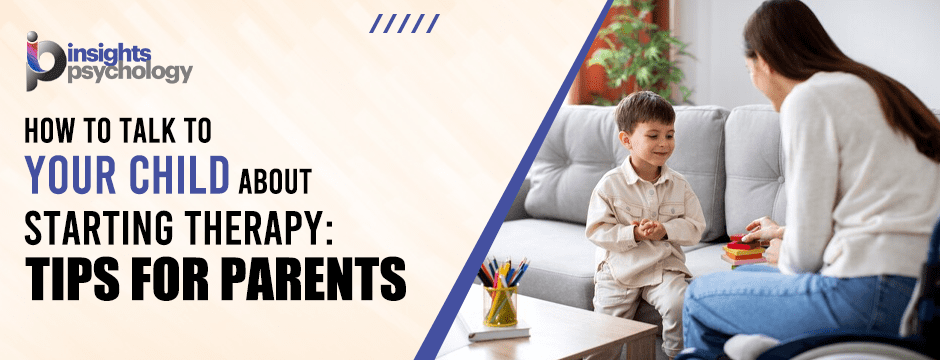Navigating the decision to start Child Therapy Services for your child can be challenging. As a parent, you want what’s best for them, but you might feel unsure about how to approach the conversation. Therapy can be an invaluable resource, providing tools and strategies to help children cope with their emotions, behaviors, and challenges. However, introducing the concept of therapy to your child requires sensitivity, patience, and clear communication.
At Insights Psychology, we understand how important it is for families to feel supported during this process. This comprehensive guide offers tips to help parents approach the topic of therapy with their children in a way that fosters trust, understanding, and cooperation. By following these steps, you can create a positive foundation for your child’s therapeutic journey.
Why Talking About Therapy Matters
The way you introduce therapy can significantly influence how your child perceives it. If approached with care, therapy can feel like an empowering experience for your child rather than something to fear or resist. Here are some key reasons why discussing therapy thoughtfully is crucial:
- Reduces Anxiety: Children often fear the unknown. Understanding what therapy entails can ease their worries.
- Builds Trust: Open communication reassures your child that therapy is a collaborative effort.
- Encourages Cooperation: When children feel included in decisions, they’re more likely to engage positively in therapy.
- Sets the Tone: Your attitude toward therapy can shape how your child views it. A positive and supportive tone can make a big difference.
Step-by-Step Guide to Talking About Therapy
1. Educate Yourself First
Before discussing therapy with your child, take time to understand what therapy involves and why it might be beneficial for them. Research different types of therapy (e.g., play therapy, cognitive-behavioral therapy) and familiarize yourself with the therapist’s approach. Knowing what to expect will help you address your child’s questions confidently.
Questions to Ask Yourself:
- What specific challenges or behaviors led you to consider therapy?
- What are your goals for Child Therapy Services?
- How can you explain therapy in age-appropriate terms?
Having clarity on these points ensures that your conversation is purposeful and reassuring.
2. Choose the Right Time and Place
Timing is everything when it comes to sensitive conversations. Pick a moment when your child feels calm and relaxed, such as during a walk, at bedtime, or over a quiet meal. Ensure you’re in a comfortable and private setting where your child feels safe to express themselves.
Tips:
- Avoid discussing therapy during moments of conflict or heightened emotions.
- Eliminate distractions, such as phones or TVs, to show your child they have your full attention.
- Be patient and prepared to give them time to process the information.
3. Use Age-Appropriate Language
Children of different ages and developmental stages will understand therapy differently. Tailor your explanation to their level of understanding. Avoid using jargon or phrases that might sound intimidating.
Child Therapy Services For Younger Children (Ages 3-8):
Use simple and reassuring language. For example:
“Sometimes, when we have big feelings or worries, it helps to talk to someone whose job is to help kids feel better. This person is called a therapist, and they have special tools to help us feel happy and strong.”
For Tweens (Ages 9-12):
Provide more context and focus on problem-solving:
“You know how when we’re sick, we visit a doctor? A therapist is like a feelings doctor who helps us figure out what’s going on inside and teaches us ways to handle tough situations.”
For Teens (Ages 13+):
Be direct and collaborative:
“I’ve noticed you’ve been going through some tough times lately. Talking to a therapist could give you a safe space to work through what you’re feeling and find ways to feel better. What do you think?”
4. Acknowledge and Validate Their Feelings
Your child might react with curiosity, hesitation, or even resistance. It’s essential to validate their emotions and let them know their feelings are normal.
Examples:
- “I understand this might feel a little scary. It’s okay to feel that way.”
- “You’re not alone in this. Lots of kids and families go to therapy, and it’s a really helpful tool.”
- “I’m here to support you every step of the way.”
By normalizing therapy and addressing their concerns, you help reduce any stigma or fear they might associate with it.
5. Explain the Role of the Therapist
Children often wonder who the therapist is and what they’ll do during sessions. Providing a clear explanation can help demystify the process.
Key Points to Cover:
- The therapist is a friendly and trained professional who listens and helps.
- Therapy sessions are a safe and private space to talk, play, or do activities.
- The goal of therapy is to make things easier for your child, whether it’s handling emotions, making friends, or feeling less worried.
You can also let them know that the therapist might talk to you (the parent) to ensure everyone is working together to help them.
6. Share Stories or Examples
If appropriate, share relatable examples to help your child feel more comfortable. You might:
- Mention a story from a book or movie where a character benefited from talking to someone.
- Share (if you’re comfortable) your own experiences with therapy or those of someone they trust.
- Highlight how therapy has helped other kids with similar challenges.
Stories can make therapy feel more familiar and less intimidating.
7. Focus on Strengths, Not Weaknesses
Frame therapy as a tool to build on their strengths rather than fix something that’s “wrong.” Emphasize their courage in taking steps to feel better and grow.
Reassuring Phrases:
- “Therapy isn’t about being broken; it’s about learning and growing.”
- “This is a chance to discover new skills that can help you feel your best.”
- “You’re already strong, and therapy will make you even stronger.”
8. Address Common Misconceptions
Children may have preconceived notions about therapy, often influenced by media or peers. Take time to dispel myths and set realistic expectations.
Common Misconceptions to Address:
- “Therapy isn’t a punishment. It’s a way to help.”
- “You don’t have to talk about anything you’re not ready to share.”
- “Therapy can be fun, especially if it involves games, art, or play.”
Reassuring your child that therapy is a supportive and positive experience can ease their concerns.
9. Invite Their Input
Involving your child in the process of Child Therapy Services fosters a sense of ownership and collaboration. Ask for their thoughts and preferences:
Questions to Ask:
- “How do you feel about talking to someone?”
- “What would make you feel comfortable during sessions?”
- “Is there anything you’d like to know about therapy?”
Letting them have a say—such as choosing the time of day for sessions or meeting the therapist beforehand—can help them feel more in control.
10. Prepare Them for the First Session
Help your child know what to expect during their first therapy session. Explain that the first visit is usually a chance to get to know the therapist and discuss what they’d like to work on.
Tips for Preparing:
- Describe the setting: “You might meet in a cozy room with toys, books, or games.”
- Mention the therapist’s role: “They’ll ask questions to learn more about you.”
- Encourage honesty: “It’s okay to share how you’re feeling, even if you’re nervous.”
Reassure them that it’s normal to take time to feel comfortable and that they can ask questions at any point.
Supporting Your Child During Therapy
Once therapy begins, your role as a supportive parent remains essential. Here are some ways to stay involved:
- Maintain Open Communication: Check in with your child about how they feel after sessions.
- Respect Their Privacy: Give them space to process their thoughts while letting them know you’re available to listen.
- Collaborate with the Therapist: Stay in touch with the therapist to understand progress and how you can support your child at home.
- Be Patient: Growth takes time. Celebrate small victories and encourage your child to keep going.
Final Thoughts
Introducing Child Therapy Services is a courageous and compassionate step toward their well-being. By approaching the conversation with empathy, honesty, and positivity, you can help your child view therapy as a valuable resource rather than something to fear. Remember, seeking help is a sign of strength—for both you and your child.
At Insights Psychology, we’re here to support families every step of the way. If you have questions or need guidance, don’t hesitate to reach out. Together, we can empower your child to thrive.
Before discussing therapy with your child, check out ‘5 Signs Your Teen May Benefit from Psychological Therapy’ for deeper insights into recognizing when help is needed.

